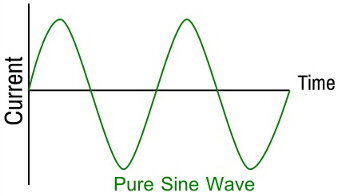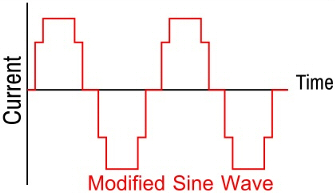Inverters
An inverter is the component of your RV power system that converts the 12V DC power from your battery into 240 volt AC power so that you can run 240VAC appliances such as you run at home. Not every RV traveller has an inverter an not every RV traveller needs one.
Do you need an inverter?
If you don't run any 240VAC appliances, the simple answer is no.
If you only run 240VAC appliances when you're connected to mains power, such as at a caravan park, again, no you don't need an inverter.
But if you want the glamping lifestyle - air conditioning, coffee machine, electric blankets, air fryer, hair dryer and more - then yes, an inverter (or possibly even two) is the way to go.
How big does an inverter need to be?
This is basically a matter of adding up the number of watts each appliance uses that you are likely to run at the same time. If you're happy to turn off your air conditioner so that you can use your microwave, then you can get by with an inverter that will run the largest power consumer.
IMPORTANT: Things like air conditioners and fridges have a running current draw and a startup current draw. The startup draw is larger, and it is this amount of power that your inverter needs to be able to cope with. Inverter fridges and inverter air conditioners can start up slowly instead of asking for a large amount of power to get them going.
This is why you'll see inverters with two power readings - the lower is what the inverter can cope with for an extended time, the higher is what it can cope with for a very short amount of time to get an appliance up and running. That "short amount of time" varies between inverters - sometimes it's only a matter of milliseconds and is really a wasted attempt to make the inverter look better than it really is. Cheap inverters are the most common to use this false impression.
Some inverters even use the input power required and not the true continuous output. We've seen some inverters on eBay that were listed as 2500W to 5000W and have been relisted as 3000W to 6000W. These inverters struggle to hold the 2500W continuous - the 3000W is how much they will require coming in in order to put that 2500W out at 230VAC.
The importance of the standby current draw and why you may want two inverters
Larger inverters tend to use more power in standby mode than smaller inverters. However, a larger inverter is often needed to power items such as air conditioners and microwaves, particularly if you want to run multiple large draw items at once.
A solution we have implemented often is to install a small and a large inverter. The small one needs to have a low standby draw but enough capacity to run anything that needs to be on all the time or frequently during the day. For example, we would use a 375W inverter to power a modern 240VAC fridge and charge laptops and phones.
We frequently install the Projecta IP2000 as it has a reasonable amount of grunt, will run some modern air conditioners and has a very small standby current draw. Be aware though that other Projecta inverters don't necessarily have the same low standby current draw.
We recommend an inverter that uses 7 watts or less when in stand by - that's less than 0.6A on a 12V inverter. These inverters tend to be more expensive. If you're prepared to turn the inverter off when it's not in use, then you can get away with a cheaper inverter with a higher standby draw.
Multi-purpose inverters
Generally the domain of larger inverters, they often are a mains charger as well. Some are even a solar controller and battery monitor, but these are physically large inverters and generally more suited to off-grid home installations. They also tend to be 24 or 48 volt. If you have a large RV such as a bus, they're certainly worth considering.
The importance of pure sine wave (PSW)
If you want to run anything that has any sort of electronic components and displays, such as a laptop or a coffee machine, you must have a pure sinewave (PSW) inverter.
The wave pattern in a pure sine wave inverter matches the wave pattern of the power that comes out of your 240V power outlet in your house:

A modified sine wave (MSW) inverter tries to approximate the wave pattern of 240V AC power:

The 'jerkiness' of the steps damages electronics and induction motors such as digital televisions, laptops and modern refrigerators. It does not damage resistive loads as long as the load doesn't have electronics in it.
How can you tell if an appliance has a resistive load?
If the appliance has a twisty knob that just points to painted marks, such as on a washing machine that doesn't have a digital display, this is a rheostat type control and it can handle a modified sine wave inverter. So can an electric blanket with a basic click control (off, 1, 2 or 3). If an appliance has press buttons and/or a display, it can't take MSW and must have a pure sinewave inverter. If you're not sure, it's better to be safe than sorry - buy a PSW inverter.
The danger of using a modified sinewave inverter on anything with electronics is that it will damage the item you're trying to run from the inverter and most likely smoke will come out.
If an inverter is pure sine wave, it will say in its specifications that it is a PSW. If it doesn't specify either PSW or MSW, then you can be fairly confident that it is only a MSW.
Battery protection
Most inverters will advertise in their specifications a battery protection alarm and a battery shutdown voltage. These figures have nothing to do with protecting your battery, and even if they did, the voltages are so low that your battery would be long dead. These figures are about protecting the inverter.
As the voltage of the battery drops, the number of amps that the inverter has to handle increases. The low voltage battery shutdown point is to prevent damage to the inverter from trying to draw too many amps.

Ideally you want to replace the power you use from your battery with nice clean, free, solar power. If there isn’t enough solar available, DC to DC charging from your engine’s alternator or pushing some power in from a mains connection or via a generator are viable alternatives.